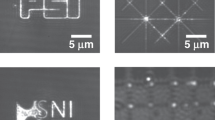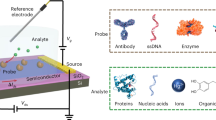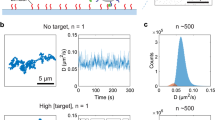Abstract
There is a growing appreciation that mechanical signals can be as important as chemical and electrical signals in biology. To include such signals in a systems biology description for understanding pathobiology and developing therapies, quantitative experiments on how solution-phase and surface chemistry together produce biologically relevant mechanical signals are needed. Because of the appearance of drug-resistant hospital ‘superbugs’, there is currently great interest in the destruction of bacteria by bound drug–target complexes that stress bacterial cell membranes. Here, we use nanomechanical cantilevers as surface-stress sensors, together with equilibrium theory, to describe quantitatively the mechanical response of a surface receptor to different antibiotics in the presence of competing ligands in solution. The antibiotics examined are the standard, Food and Drug Administration-approved drug of last resort, vancomycin, and the yet-to-be approved oritavancin, which shows promise for controlling vancomycin-resistant infections. The work reveals variations among strong and weak competing ligands, such as proteins in human serum, that determine dosages in drug therapies. The findings further enhance our understanding of the biophysical mode of action of the antibiotics and will help develop better treatments, including choice of drugs as well as dosages, against pathogens.
This is a preview of subscription content, access via your institution
Access options
Subscribe to this journal
Receive 12 print issues and online access
$259.00 per year
only $21.58 per issue
Buy this article
- Purchase on Springer Link
- Instant access to full article PDF
Prices may be subject to local taxes which are calculated during checkout





Similar content being viewed by others
References
Ghatkesar, M. K., Lang, H-P., Gerber, C., Hegner, M. & Braun, T. Comprehensive characterization of molecular interactions based on nanomechanics. PLoS ONE 3, 1–6 (2008).
Dwyer, D. J. et al. Antibiotic-induced bacterial cell death exhibits physiological and biochemical hallmarks of apoptosis. Mol. Cell 46, 561–572 (2012).
Kohanski, M. A., Dwyer, D. J., Wierzbowski, J., Cottarel, G. & Collins, J. J. Mistranslation of membrane proteins and two-component system activation trigger antibiotic-mediated cell death. Cell 135, 679–690 (2008).
Zeitlinger, M. A. et al. Protein binding: do we ever learn? Antimicrob. Agents Chemother. 55, 3067–3074 (2011).
Bailey, E. M., Rybak, M. J. & Kaatz, G. W. Comparative effect of protein binding on the killing activities of teicoplanin and vancomycin. Antimicrob. Agents Chemother. 35, 1089–1092 (1991).
Perkins, H. R. Specificity of combination between mucopeptide precursors and vancomycin or ristomycin. Biochem. J. 111, 195–205 (1969).
Beauregard, D. A., Williams, D. H., Gwynn, M. N. & Knowles, D. J. Dimerization and membrane anchors in extracellular targeting of vancomycin group antibiotics. Antimicrob. Agents Chemother. 39, 781–785 (1995).
Lai, C-Y. et al. A mesoporous silica nanosphere-based carrier system with chemically removable CdS nanoparticle caps for stimuli-responsive controlled release of neurotransmitters and drug molecules. J. Am. Chem. Soc. 125, 4451–4459 (2003).
Sieradzki, K. et al. The development of vancomycin resistance in a patient with methicillin-resistant Staphylococcus aureus infection. N. Engl. J. Med. 340, 517–523 (1999).
McKay, G. A et al. Time–kill kinetics of oritavancin and comparator agents against Staphylococcus aureus, Enterococcus faecalis and Enterococcus faecium. J. Antimicrob. Chemother. 63, 1191–1199 (2009).
Minamide, L. S. & Bamburg, J. R. Filter paper dye-binding assay for quantitative determination of protein without interference from reducing agents or detergents. Anal. Biochem. 190, 66–70 (1990).
Lonnroth, P., Jansson, P. A. & Smith, U. A microdialysis method allowing characterization of intercellular water space in humans. Am. J. Physiol. 253, E228–E231 (1987).
Nasir, M. S. & Jolley, M. E. Fluorescence polarization: an analytical tool for immunoassay and drug discovery. Combin. Chem. High Throughput Screen. 2, 177–190 (1999).
Frostell-Karlsson, A. et al. Biosensor analysis of the interaction between immobilised human serum albumin and drug compounds for prediction of human serum albumin binding levels. J. Med. Chem. 43, 1986–1992 (2000).
Ndieyira, J. W. et al. Nanomechanical detection of antibiotic–mucopeptide binding in a model for superbug drug resistance. Nature Nanotech. 3, 691–696 (2008).
Arlett, J. L., Myers, E. B. & Roukes, M. L. Comparative advantages of mechanical biosensors. Nature Nanotech. 6, 203–215 (2011).
Fritz, J. et al. Translating biomolecular recognition into nanomechanics. Science 288, 316–318 (2000).
Shekhawat, G., Tark, S-H. & Dravid, V. P. MOSFET-embedded microcantilevers for measuring deflection in biomolecular sensors. Science 311, 1592–1595 (2006).
Williams, D. H., Maguire, A. J., Tsuzuki, W. & Westwell, M. S. An analysis of the origins of a cooperative binding energy of dimerisation. Science 280, 711–714 (1998).
Allen, N. E. & Nicas, T. I. Mechanism of action of oritavancin and related glycopeptide antibiotics. FEMS Microbiol. Rev. 93, 511–532 (2003).
Sun, H., Maderazo, E. G. & Krusell, A. R. Serum protein-binding characteristics of vancomycin. Antimicrob. Agents Chemother. 37, 1132–1136 (1993).
Arhin, F. F. et al. Effect of polysorbate 80 on oritavancin binding to plastic surfaces: implications for susceptility testing. Antimicrob. Agents Chemother. 52, 1597–1603 (2008).
Yung-Chi, C. & Prusoff, W. H. Relationship between the inhibition constant (K3) and the concentration of the inhibitor which causes 50 per cent inhibition (I50) of an enzymatic reaction. Biochem. Pharmacol. 22, 3099–3108 (1973).
Allen, N. E., LeTourneau, D. L. & Hobbs, J. N. Jr The role of hydrophobic side chains as determinants of antibacterial activity of semisynthetic glycopeptide antibiotics. J. Antibiot. 50, 677–684 (1997).
Cooper, M. A., Fiorini, M. T., Abell, C. & Williams, D. H. Binding of vancomycin group antibiotics to D-alanine and D-lactate presenting self-assembled monolayers. Bioorg. Med. Chem. 8, 2609–2616 (2000).
Rao, J., Yan, L., Xu, B. & Whitesides, G. M. Using surface plasmon resonance to study the binding of vancomycin and its dimer to self-assembled monolayers presenting D-Ala–D-Ala. J. Am. Chem. Soc. 121, 2629–2630 (1999).
Cooper, M. A., Williams, D. H. & Cho, Y. R. Surface plasmon resonance analysis of glycopeptide antibiotic activity at a model membrane surface. Chem. Commun. 17, 1625–1626 (1997).
Mercier, R-C., Houlhan, H. H. & Rybak, J. M. Pharmacodynamic evaluation of a new glycopeptide, LY333328, and in vitro activity against Staphylococcus aureus and enterococcus faecium. Antimicrob. Agents Chemother. 41, 1307–1312 (1997).
McKay, G. A., Beaulieu, S., Lehoux, D., Parr, J. R. T. & Moeck, G. Methods of treating bacterial infections using oritavancin. US patent 0035097 A1 (2012).
Vuignier, K., Schappler, J., Veuthey, J-L., Carrupt, P-A. & Martel, S. Drug–protein binding: a critical review of analytical tools. Anal. Bioanal. Chem. 398, 53–66 (2010).
Rotschafer, J. C. et al. Pharmacokinetics of vancomycin: observations in 28 patients and dosage recommendations. Antimicrob. Agents Chemother. 22, 391–394 (1982).
Bell, G. I. Models for the specific adhesion of cells to cells. Science 200, 618–627 (1978).
Wu, Y. et al. Transforming binding affinities from three dimensions to two with application to cadherin clustering. Nature 475, 510–513 (2011).
Acknowledgements
The authors acknowledge support, funding and materials from the EPSRC Interdisciplinary Research Centre in Nanotechnology (Cambridge, UCL, Bristol, GR/R45680/01), the Royal Society (RS), Bio Nano Consulting (BNC), Targanta Therapeutics, EPSRC Speculative Engineering Program (EP/D505925/1), the European Union FP7 Project VSMMART Nano (managed by BNC), EPSRC Grand Challenge in Nanotechnology for Healthcare (EP/G062064/1) and the EPSRC IRC in Early Warning Sensing Systems for Infectious Diseases (EP/K031953/1). M.A.C. acknowledges support from NHMRC Australia Fellowship AF511105. The authors thank S. B. Patil, G. T. Charras and I. K. Robinson for discussions.
Author information
Authors and Affiliations
Contributions
J.W.N., R.A.M. and G.A. conceived and designed the experiments. J.W.N. and G.A. formulated the mathematical models to quantify the transduction between chemical and mechanical signals to uncover the role of strong and weak competing ligands in the functionality of drugs and to show quantitatively how surface binding affinity is correlated with competing solution phase processes. J.W.N. performed the experiments and wrote the paper. All authors discussed the results and commented on the manuscript.
Corresponding authors
Ethics declarations
Competing interests
Research was partially funded by Targanta via Bio-Nano Consulting and Targanta had a financial interest in the commercial success of Oritavancin. G.A. is co-author of two patents (US2010/0149545 and EP2156441 A1: G. Aeppli and B. Dueck: “Apparatus and Methods for measuring deformation of a cantilever using interferometry”, publication 24th Feb 2010 and WO 2013144646 A3: R. Hermans and G. Aeppli: “Measuring Surface Curvature”, publication 21st November 2013) whose value could increase if the methods and ideas described in this paper find widespread application.
Supplementary information
Supplementary information
Supplementary information (PDF 744 kb)
Rights and permissions
About this article
Cite this article
Ndieyira, J., Kappeler, N., Logan, S. et al. Surface-stress sensors for rapid and ultrasensitive detection of active free drugs in human serum. Nature Nanotech 9, 225–232 (2014). https://doi.org/10.1038/nnano.2014.33
Received:
Accepted:
Published:
Issue Date:
DOI: https://doi.org/10.1038/nnano.2014.33
This article is cited by
-
Optoplasmonic characterisation of reversible disulfide interactions at single thiol sites in the attomolar regime
Nature Communications (2020)
-
Conformational detection of heat shock protein through bio-interactions with microstructures
Research on Biomedical Engineering (2020)
-
Modified cantilever arrays improve sensitivity and reproducibility of nanomechanical sensing in living cells
Communications Biology (2018)
-
Atomic force microscopy-based characterization and design of biointerfaces
Nature Reviews Materials (2017)
-
Surface mediated cooperative interactions of drugs enhance mechanical forces for antibiotic action
Scientific Reports (2017)



